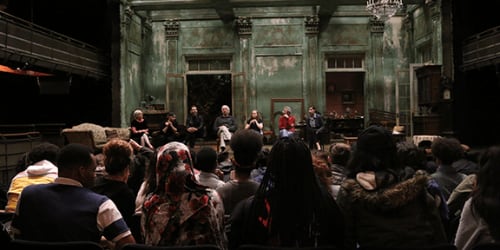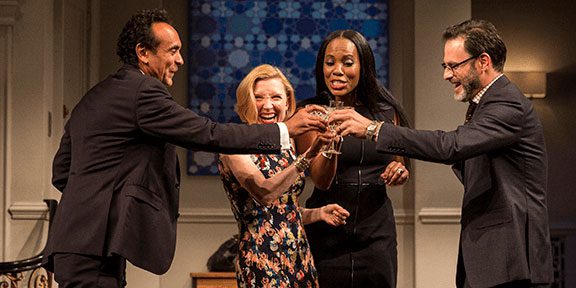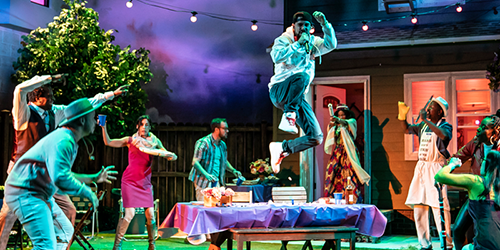- Tickets
- Memberships & Season
- Engage & Learn
- Your Visit
- Support
- Artists
- About
- Accountability
- Ticket Donation Requests
- Financials
- Rentals at the Goodman
- Our History
- Staff & Leadership
- Join the Goodman
- Press Room
- 2024-2025 Season
- 2023 – 2024 Season
- 2022 – 2023 Season
- 2021 – 2022 Season
- 2019 – 2020 Season
- Hershey Felder as Irving Berlin
- Goodman Gala
- A Paris Love Story
- Bernhardt Hamlet
- The Santaland Diaries
- American Mariachi
- School Girls; Or, The African Mean Girls Play
- Molly Sweeney
- graveyard shift
- Roe
- 42nd Annual Production of A Christmas Carol
- Dana H
- Daughter of a Cuban Revolutionary
- New Stages Festival 2019
- 2018 – 2019 Season
- 2017 – 2018 Season
- 2016 – 2017 Season
- 2015 – 2016 Season
- 2014 – 2015 Season
- About the Goodman
Artist Bio

James Baldwin
James Arthur Baldwin was born in New York’s Harlem Hospital on August 2, 1924, the illegitimate child of Emma Berdis Jones and a father he never met. His mother married David Baldwin, Sr., when James was still a baby; until he overheard an argument as a teenager, he grew up believing that Baldwin was his real father. Berdis and David had eight other children, as well as a son by David’s previous marriage. James’ youngest sibling, Paula, was born on July 29, 1943; his stepfather died of tuberculosis the same day.
David Sr. was a Baptist preacher by calling and a factory worker by trade. Strict and arbitrary at home, his weekend sermons at the neighborhood pentecostal church bristled with prophecies of fire and damnation. He forbade his children to go to movies or listen to jazz on the radio, and he considered white people to be evil incarnate. His ambitions for his children were circumscribed by his own harsh view of the world.
In elementary school James drew the attention of several educators who took him under their wing. Gertrude Ayer, the first black principal in New York’s public schools, was perhaps the first to recognize James’ exceptional qualities. Orilla Miller, a white intern assigned to P.S. 24 through the WPA’s Theatre Project, directed his first play and took him to museums, movies, and the theater after school and on weekends.
At Frederick Douglass Junior High, James came under the influence of Countee Cullen, the acclaimed poet and one of the great figures of the Harlem Renaissance, who introduced James and his classmates to the work of great black writers and shared his experiences of living in France. Herman Porter, James’ math teacher, was also advisor to the school newspaper, The Douglass Pilot, for which James served as editor.
It was during his time at Frederick Douglass that James started attending church services at Mt. Calvary of the Pentecostal Faith. In a moment of ecstatic possession, James threw himself at the foot of the altar and was “saved” by Mother Horn, the church’s charismatic leader and the model for Sister Margaret in The Amen Corner. Shortly thereafter he became an apprentice preacher at another storefront church, the Fireside Pentecostal Assembly. James’ rhetorical style created a sensation and, for the next three years, the “Little Minister” delivered sermons of such passion and conviction that they overshadowed his stepfather’s ministry.
After graduating from DeWitt Clinton High School in 1942, Baldwin supported himself for the next six years with a succession of menial jobs, including one at a defense factory in New Jersey. He moved to Greenwich Village and began to move in circles that included Paul Robeson, Burt Lancaster, Marlon Brando, Eartha Kitt and the painter Beauford Delaney, who became an important mentor for Baldwin. With his friends Brad and Claire Burch, Baldwin started a literary magazine called This Generation, to which he contributed a chapter from “In My Father’s House,” a short story that he would later develop into The Amen Corner. The more tolerant environment of Greenwich Village also gave Baldwin the opportunity to explore sexual feelings that he had largely repressed.
In 1945 Baldwin met one of his literary heroes, Richard Wright, the author of Native Son, and gave him a draft section of Go Tell It on the Mountain, his autobiographical first novel. Wright was impressed enough to recommend Baldwin for a $500 fellowship from the. Eugene F. Saxton Foundation.
In November of 1948, depressed by the lack of progress on Go Tell It on the Mountain and other setbacks, Baldwin purchased a one-way plane ticket to France and arrived in Paris with $40 in his pocket. There he formed essential associations with other writers such as Saul Bellow, Jean-Paul Sartre and Philip Roth. The move to Paris gave Baldwin a fresh perspective on his life, his work and his homeland. Although professional frustrations and personal tragedies would continue to plague Baldwin, from 1948 on his career as a writer was assured.
During the next 40 years, Baldwin produced an extraordinary body of fiction and non-fiction works, including Go Tell It on the Mountain (1953), Notes of a Native Son (1955), Giovanni’s Room (1956), Another Country (1962), The Fire Next Time (1963), Blues for Mr. Charlie (1964), The Amen Corner (1968), The Devil Finds Work (1976), Just Above My Head (1979), The Evidence of Things Not Seen (1986), and The Welcome Table (his last project, an unfinished play). For his achievements, he garnered numerous commendations, including the National Institute of Arts and Letters Award (1956) and the French Legion of Honor (1986). Although France remained his primary place of residence, Baldwin traveled extensively and lived for periods of time in Switzerland, Turkey, Corsica and the United States.
In 1963, at the height of the American civil rights movement, his picture appeared on the cover of the May 17 issue of Time. In The Fire Next Time he predicted that the failure of white and black Americans to come to terms with their fear and hatred of one another would result in widespread violence. In his travels through the South, which included marching with Martin Luther King, Baldwin interviewed countless men and women whose lives had been short-changed by segregation. On May 24, 1963, Baldwin was one of several activists (including Lorraine Hansberry) who met with Attorney General Robert Kennedy to challenge the government to take more vigorous action in the civil rights struggle. Twenty-three years later, in The Evidence of Things Not Seen, Baldwin would re-examine racism in America through the lens of the Atlanta child murders.
Baldwin was diagnosed with cancer of the esophagus in April of 1987. Laser treatments and surgery granted him only a brief respite; within two months, the cancer had spread to his liver and other organs. Frail and confined to bed through much of the late summer and fall, Baldwin remained alert and mentally active until shortly before his death early in the morning of December 1, 1987, at his home in France. Baldwin ‘s body was flown to New York, where his funeral was held at the Cathedral of St. John the Divine on December 8. The service included gospels sung by Odetta, and a eulogy delivered by Amiri Baraka, who called Baldwin “God’s black revolutionary mouth.” The funeral procession wound its way through the streets of Harlem to Ferncliff Cemetery, where Baldwin was laid to rest near Malcolm X and Paul Robeson.






















